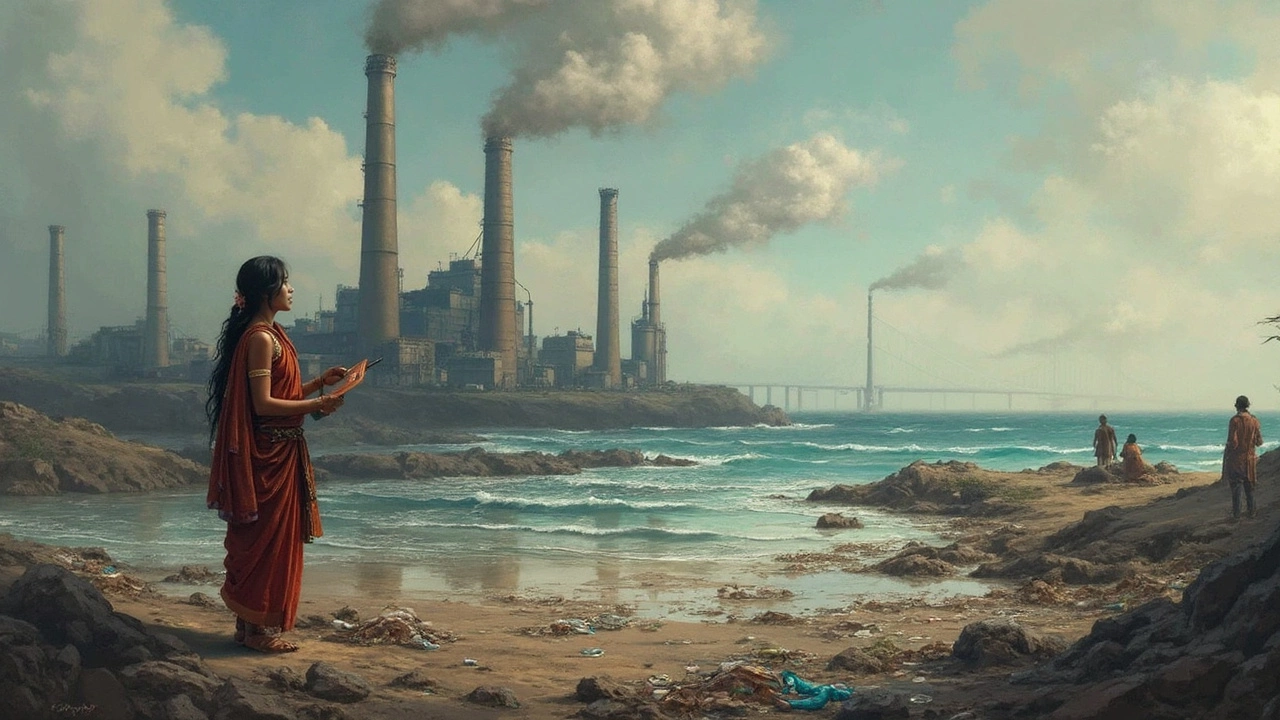Plastic waste floating in our oceans isn’t just some distant environmental issue; it’s a crisis we’re all wrapped up in, like it or not. If you’ve ever wondered who’s responsible for all that mess, you’re not alone. A big chunk of blame falls on plastic manufacturing companies. These guys produce a mind-boggling amount of material, and without proper checks, a lot of it ends up where it really shouldn't—our oceans.
We’ve all seen those heartbreaking images of turtles tangled up in plastic or seabirds swallowing bottle caps. The truth is, the issue goes deeper than that. Millions of tons of plastic are dumped into the oceans every year. You might be thinking it's all about careless beach-goers, but there’s more. Sure, perfect storm situations and littering on beaches play a role, but the big guys—the manufacturers—are where we see the glaring issues.
- Identifying Plastic Polluters
- Impact of Plastic Waste on Marine Life
- Roles of Plastic Manufacturers
- Recycling and Waste Management
- Solutions and Preventive Measures
Identifying Plastic Polluters
When we talk about plastic pollution and who’s really behind it, fingers often point right at manufacturers. These companies crank out massive amounts of plastic bottles, bags, and packaging materials. But it’s not just about the sheer volume; it’s what happens after production that matters too.
Plastic waste from manufacturers often finds its way into oceans due to poor waste management and recycling systems. Ever hear about that Pacific Garbage Patch? It’s a giant floating island of trash, and it’s not just from individuals tossing their coffee cups overboard. A lot of it comes from factories not handling their output responsibly. Wastewater management failures also contribute, carrying tiny plastics into the sea.
Studies have shown that 20 companies alone are responsible for producing over 50% of single-use plastic waste worldwide. These include big names like ExxonMobil and Dow. They supply the raw material to make these plastics, which then end up in products we use daily and eventually litter our oceans.
Another layer to this problem is the 'export' of plastic waste. Developed countries have long sent their scrap plastics to developing nations, where regulations can be lax, leading to more ocean dumping. This practice leaves poorer countries dealing with loads of plastic they haven't created.
What we really need to change is how these companies and countries handle waste. Tightening regulations at the source—by holding manufacturers accountable for their environmental impact—could be a game-changer. It’s not just about banning plastic straws; it’s about creating systems that push these companies to act responsibly.
Impact of Plastic Waste on Marine Life
The damage caused by plastic pollution in the ocean is nothing short of catastrophic for marine life. Imagine living in a world where your home is constantly filling with trash, making it hard to breathe, eat, or even move. That’s the reality for countless creatures in our oceans today. Plastic is scattered everywhere, from the deepest parts of the Mariana Trench to the far reaches of the Arctic Ocean.
Believe it or not, an estimated 8 million metric tons of plastic waste end up floating in our oceans every year. That’s like emptying a garbage truck full of plastic into the ocean every minute. Marine animals, like turtles, mistake plastic bags for jellyfish, resulting in choking or fatal blockages. Birds, too, often ingest little bits of plastic, confusing them for fish or other food.
But it’s not just big, visible pieces we have to worry about. The real sneaky villain here is the microplastic: tiny particles made when larger plastics break down. These little particles get into the food chain, starting from plankton and moving up to fish and even into our dinner plates. And that’s a diet nobody signed up for, right?
Plastic waste also harms coral reefs, which are vital ecosystems for many marine species. They get smothered by debris, blocking sunlight and affecting photosynthesis. Damaged corals lose their vibrant colors and become much less hospitable to fish and other ocean life that depend on them.
| Animal Type | Common Plastic Impact |
|---|---|
| Sea Turtles | Ingestion of plastic bags, choking hazards |
| Seabirds | Plastic ingestion leading to starvation |
| Fish | Consumption of microplastics, toxins entering the food chain |
| Coral Reefs | Damage and smothering by larger debris |
Fixing this mess isn’t about a quick cleanup; it’s about stopping more plastic from sneaking into the ocean in the first place. And that means everyone, from everyday people to the plastic manufacturers, has to help turn off the plastic tap.

Roles of Plastic Manufacturers
When it comes to the plastic pollution mess, plastic manufacturers aren't exactly off the hook. These companies are major players in the game, responsible for churning out plenty of plastic that, when not managed properly, ends up in our oceans.
First off, consider this: plastic production has skyrocketed to over 368 million metric tons every year. With that kind of volume, there’s a lot of room for things to slip through the cracks. A huge part of the problem is tied to how these companies handle their waste and byproducts. Ineffective disposal methods and a lack of accountability mean that a surprising amount of plastic garbage is mishandled or even illegally dumped into bodies of water.
There's more to it. You know those tiny plastic pellets called nurdles? They’re the raw material for other plastic products. Accidental spills and improper storage of these microbeads create serious environmental hazards. An estimated 230,000 tons of nurdles enter our ocean every year. That’s a ton of tiny, nearly invisible plastic harming marine life.
"If we are to resolve the plastic pollution crisis, manufacturers must embrace responsibility and drive innovation towards sustainable solutions," said Dr. Jane Goodall, renowned environmentalist.
Manufacturers also shrug off their share of the blame through the so-called 'planned obsolescence.' They produce items meant to be disposed of or replaced quickly, increasing overall waste. By creating more durable, recyclable items, they could significantly cut down on ocean waste.
On a brighter note, quite a few companies are taking steps toward sustainability. Some are investing in biodegradable plastics and others are turning to eco-friendly packaging. Still, there’s a long way to go. It’s crucial that these firms, especially the larger ones, invest more heavily in recycling technologies and partner with governments to enforce better waste management practices. This is not just about cleaning up; it’s about preventing the mess in the first place.
Recycling and Waste Management
Alright, let's talk about the elephant—or rather, the plastic—in the room: Recycling and Waste Management. I know it sounds boring, but stick with me; it's more interesting than you think. Effective recycling is like the secret sauce to tackling our plastic problem. We all know recycling is supposed to be a good thing, right? But it doesn't always go as planned.
Here's the deal. In 2023, global recycling rates for plastic were only about 9%. Yeah, you heard that right. The rest? Often dumped, landfilled, or lost in the ocean. Why? Because not all plastics are recyclable. Those little codes on the bottom of your containers tell you what can be recycled, but without proper education and infrastructure, that knowledge isn't all that helpful.
Let's bring waste management into the spotlight. Many countries still lack the systems to handle vast amounts of plastic waste. Picture this: tons of waste being collected but with nowhere to go. What happens? Incineration or worse—dumping. Some nations export their waste, literally shipping off the problem, which doesn't really solve things.
Now, about the companies. Big plastic producers hold a massive role here. They’re starting to see the light and invest in technologies like chemical recycling that break plastic down to its original building blocks, making it possible to reuse it like brand new. And that’s a win-win.
But hey, don’t despair! We can help tweak the system from our end too. Here's a quick list of what we can all do:
- Know what can be recycled: Look up your local recycling rules and stick them on your fridge. Education is key.
- Reduce first: Try to cut down single-use plastics. It's easier than it sounds, trust me.
- Pressure those companies: Consumer demand can lead to change. Ask for products with sustainable packaging.
If everyone from your neighbor to those big plastic manufacturing companies pitches in, we can slow down this tidal wave of ocean garbage. It's not just about one person; it's about all of us shifting gears together.

Solutions and Preventive Measures
So, thinking about solutions to all this ocean plastic mess, it might feel like combating a giant, right? But hang on, there are some strides worth talking about. First off, having a solid recycling culture is super important. If plastic manufacturing companies stepped up their recycling game, it would make a massive difference. Many companies are actually starting to shift towards sustainable practices by using recycled materials and designing products for easier recycling.
Now, how about technology lending a hand? We’ve got innovations coming in strong, like bio-degradable plastics, which break down faster, leaving less harm in the environment. And there’s more: tech-driven ocean clean-up projects are gathering steam, literally pulling plastics out of the ocean.
Governments can shoulder some responsibility too. Policies against single-use plastics are popping up worldwide, and these can seriously curb plastic pollution if enforced consistently. Imagine if every country banned plastic straws and bags—huge, right? Plus, incentivizing companies to develop eco-friendly products can tip the scales in favor of a cleaner environment.
But hang tight, it's not just on the big players and policymaker's shoulders. People, like you and me, can bring in impactful changes by making small shifts. For instance, whenever possible, choose products with minimal plastic packaging. Reusable bags, bottles, and even cutlery might just be the low-hanging fruits of the fight against plastic waste.
- Opt for brands known for their environmental commitment.
- Encourage local businesses to adopt recyclable packaging.
- Start or join community clean-up events—get those beaches looking sharp!
- Get vocal. Share info, raise awareness, and educate others.
To give you a closer look, check out how changes can ripple out:
| Action | Potential Impact |
|---|---|
| Switching to reusable bags | Reduces plastic bag use by thousands annually per person |
| Community clean-ups | Can remove 10,000+ plastic items in one event |
| Industrial recycling mandates | Saves 700,000 barrels of oil annually |
We can tackle this plastic problem, one piece at a time. It might sound cliché, but every little bit counts. Imagine Bruno, my pet dog, running freely on a clean beach—that’s the kind of world we’re aiming for, right?
